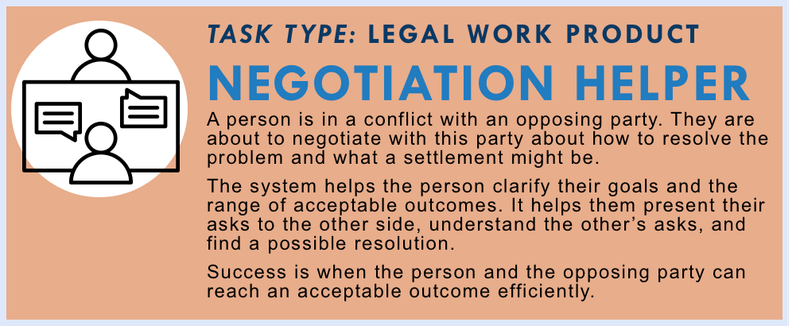Negotiation Helper

Help people prepare for and engage in negotiation by clarifying goals, understanding trade-offs, and exploring workable resolutions.
Task Description
When someone is in a legal or civil conflict—whether with a landlord, creditor, employer, agency, or family member—they are often encouraged or required to negotiate a resolution. But negotiating well requires preparation, clarity, and confidence. People need to know what they want, what they can accept, and how to navigate what the other party is proposing.
This task focuses on a system that acts as a negotiation guide and strategic assistant. It helps the person define their key goals, must-haves, and limits. It then assists in organizing and presenting their position clearly and respectfully to the other side. During or after conversations, the system helps interpret the other party’s position and suggests potential compromises or mutually beneficial resolutions.
The system doesn’t replace human judgment or offer legal advice. Instead, it creates structure and strategy—helping users explore their BATNA (best alternative to a negotiated agreement), model different outcomes, and prepare scripts or talking points. It also helps document the conversation and draft possible written agreements.
This is especially useful in high-stakes but informal settings, like housing negotiations, debt resolution, workplace disputes, or family conflicts. It supports self-represented people and community navigators alike, reducing power imbalances and increasing clarity.
Success means that the person reaches a fair, acceptable outcome more efficiently—with a greater sense of agency, understanding, and preparedness throughout the negotiation process.
How to Measure Quality?
🎯 Clarity of Goals and Limits
- Helps user articulate short- and long-term goals, non-negotiables, and fallback options
- Differentiates between legal rights and personal preferences
- Flags internal inconsistencies or missing priorities
🧠 Preparation for Negotiation
- Generates talking points or “asks” tailored to the issue and user goals
- Includes framing suggestions that build rapport or credibility
- Helps user anticipate counterarguments and emotional triggers
🤝 Understanding of the Other Party
- Helps identify what the other party might want or need
- Suggests possible win-win outcomes or leverage points
- Interprets language used by the other party and flags red flags or signals
📑 Agreement Building Support
- Proposes draft terms or resolution language based on negotiation progress
- Helps document agreed terms clearly and neutrally
- Checks whether key elements (e.g., deadlines, responsibilities) are included
💬 Communication Support
- Uses plain, respectful language that reflects the user’s tone and situation
- Offers multiple phrasings for difficult topics or emotional issues
- Helps the user balance firmness with openness to resolution
⏱️ Efficiency and Confidence
- Reduces time needed to prepare for negotiation
- Increases user understanding of process and options
- User reports feeling more confident and in control throughout the interaction